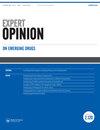Is clinical trial data showing positive progress for the treatment of eosinophilic esophagitis?
IF 2.7
3区 医学
Q2 PHARMACOLOGY & PHARMACY
引用次数: 0
Abstract
Eosinophilic gastrointestinal disorders (EGIDs) are characterized by GI tract dysfunction (dysphagia, vomiting, gastro-esophageal reflux, abdominal pain, diarrhea, etc.) and findings of increased tissue eosinophils on biopsy. These disorders can affect any segment of the GI tract, and the best characterized is eosinophilic esophagitis (EoE). Originally described as a distinct entity in the 1990s, EoE is now recognized worldwide with defined clinical, endoscopic, and histologic diagnostic criteria as well as widely accepted guidelines for management [1]. Treatment options include food elimination diets, which focus on removal of the triggering food(s), or use of medications, to induce disease remission. There are generally three categories of medications utilized: proton-pump inhibitors (PPIs), swallowed, topical corticosteroids (TCS), and biologics. In EoE, PPIs function as anti-inflammatory agents by decreasing the expression of Th2 (allergic) cytokines and improving the disrupted barrier function of the esophagus. Swallowed, topical corticosteroids and many biologics function in a similar way: downregulation of Th2 cytokines, repair of esophageal barrier function, and prevention of tissue remodeling. In trials of PPIs, between 20% and 50% of patients demonstrate clinical and histologic improvement with high-dose monotherapy and the majority maintain this with long-term use [2]. PPIs are positioned among the first-line treatments for EoE, although they are not approved by the FDA in the United States for this indication. TCS have undergone the most extensive evaluation of any therapeutic for EoE. There are currently two formulations utilized in the United States: budesonide, which is mixed into a ‘slurry,’ and fluticasone propionate, which is administered as an aerosol through an MDI device. Both formulations are swallowed, providing a topical effect in the esophagus and each is effective for both induction of clinical and histological remission of EoE as well as long-term maintenance therapy [3]. Biologics have garnered much recent attention, likely due to their success in a variety of other disorders including atopic diseases such as asthma and atopic dermatitis. Based upon this discussion, it would seem clear that there are multiple, effective therapies for EoE; however, until recently none have been approved by the FDA for use in the United States. The reasoning behind this, at least in part, can likely trace back to how EoE is diagnosed and the challenges faced in therapeutic trials for this disease. EoE is a clinicopathologic diagnosis requiring both clinical symptoms of gastrointestinal dysfunction and histologic findings of increased eosinophils/eosinophil activity in the affected tissue [4]. Treatment outcomes have focused on reducing tissue eosinophil load and improving the clinical symptoms and endoscopic features [5]. In early clinical trials, the results were often hampered by a lack of standardized outcome measures [6–8]. In addition, there has been a lack of consensus on how to define disease ‘remission’ when evaluating changes in tissue eosinophil counts. Various cutoff points have been utilized (≤15 eos/hpf to ≤5 eos/hpf) making comparisons between trials difficult [9]. Recently, standardized measures have been validated for clinical (Pediatric Eosinophilic Esophagitis Score (PEES), PedsQL, dysphagia symptom questionnaire (DSQ), etc.), endoscopic (EoE endoscopic reference score (EREFS)), and histologic (EoE histology scoring system (HSS)) outcomes allowing for improved trial design [5]. In 2019, the FDA announced the development of guidelines for industrial trials of drugs for EoE [10]. Several key criteria were announced: all trials should be randomized, double-blind, placebo controlled and should treat for a minimum period of 24 weeks with an extension to 52 weeks to evaluate for safety and long-term efficacy. Assessment of efficacy should focus on utilization of standardized clinical outcome measures, improvement of endoscopic findings, and the ability of the treatment to reduce peak esophageal eosinophils to ≤6 eos/ hpf and improve other histologic abnormalities. Since publication of the FDA guidance, several therapeutics have completed or are nearing completion of late-phase clinical trials. In a phase 3 trial of over 300 adolescent and adult patients with EoE who were treated over 12 weeks, budesonide oral suspension (BOS) led to a reduction in tissue eosinophils to ≤6/hpf in 53.1% of treated subjects, compared to only 1% of the placebo group [11]. BOS was also associated with significant improvements in clinical symptoms and endoscopic features, compared to placebo. A follow-up study evaluating long-term outcomes was performed in subjects who completed the initial BOS trial. Subjects who were considered临床试验数据显示嗜酸性粒细胞性食管炎的治疗有积极进展吗?
本文章由计算机程序翻译,如有差异,请以英文原文为准。
求助全文
约1分钟内获得全文
求助全文
来源期刊
CiteScore
5.90
自引率
0.00%
发文量
28
审稿时长
>12 weeks
期刊介绍:
Expert Opinion on Emerging Drugs (ISSN 1472-8214 [print], 1744-7623 [electronic]) is a MEDLINE-indexed, peer-reviewed, international journal publishing structured reviews on Phase II and Phase III drugs/drug classes emerging onto the market across all therapy areas, providing expert opinion on their potential impact on the current management of specific diseases.

 求助内容:
求助内容: 应助结果提醒方式:
应助结果提醒方式:


